生物英文文献的讲解和梳理
微生物专题英文文献
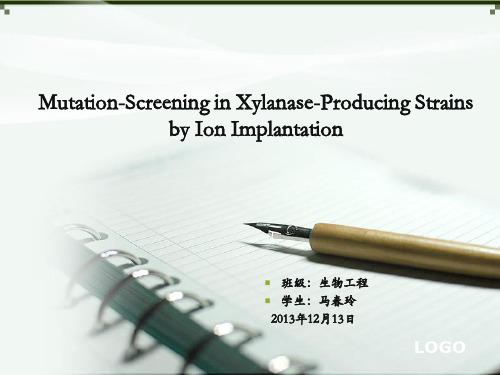
班级:生物工程 学生:马春玲 2013年12月13日
LOGO
试验内容
1. Purpose and meaning 2. Introduction 3. Materials and methods
4.5 正交试验结果
Table 5. Results of ortho.1 Trend curve
Fig.2 Relationship between xylanase and time of fermentation in Aspergillus niger N212
通过对出发菌株注入不同剂量的氮离子,低能氮离子 束对菌体细胞均有一定程度的致死和损伤作用,细胞及其 损伤DNA又在其修复系统的作用下得到不同程度的修复, 从而导致黑曲霉孢子的存活率先下降,后上升,然后又下 降,并且菌种的修复出错会使其突变率大大提高,从而提 高了菌株的正突变率,从而确定了氮离子最佳注入参数。 以上试验可以得出最优培养基的组成(即各组分的最 适浓度),而且在以上培养得到了黑曲霉N212(表2),当 它发酵60个小时后酶活达到600IU/ml,比之前未优化的菌 株减少了12个小时,而且相对于原出发菌株酶活增加了100 %。 试验证明离子注入对微生物进行诱变改良是一种行之 有效的诱变技术。
木聚糖酶是植物细胞壁的主要之一,属 于非淀粉多糖。可作为生物漂白剂用于造纸工 业,也可用于生物转化等等。目前木聚糖酶的 生产主要还依靠真菌。
对于产酶微生物的育种,国外多采用基因工程手段 构建高产菌,而国内多采用传统的诱变方法,如紫外辐 射、化学诱变剂处理等,这些诱变手段获得的突变株一 般稳定性差、容易产生回复突变且负突变较多及诱变选 育的工作量很大,而20世纪80年代末,人们发现离子束 可以引起靶物质原子移位和重排,使细胞表面刻蚀和穿 孔,并能影响和改变细胞电性等现象,提出了离子束可 以用于细胞加工和基因转移的设想,并陆续得到了研究 证实,由此产生了国内外普遍关注的离子束生物技术工 程学,而且离子束育种是一项具有我国自主知识产权且 被国际所承认的定向遗传改良的集物理诱变和化学诱变 于一身的综合诱变方法,具有损伤小、突变谱广、突变 率高的特点。
微生物英文文献及翻译—翻译

A/O法活性污泥中氨氧化菌群落的动态与分布摘要:我们研究了在厌氧—好氧序批式反应器(SBR)中氨氧化菌群落(AOB)和亚硝酸盐氧化菌群落(NOB)的结构活性和分布。
在研究过程中,分子生物技术和微型技术被用于识别和鉴定这些微生物。
污泥微粒中的氨氧化菌群落结构大体上与初始的接种污泥中的结构不同。
与颗粒形成一起,由于过程条件中生物选择的压力,AOB的多样性下降了。
DGGE测序表明,亚硝化菌依然存在,这是因为它们能迅速的适应固定以对抗洗涤行为。
DGGE更进一步的分析揭露了较大的微粒对更多的AOB种类在反应器中的生存有好处。
在SBR反应器中有很多大小不一的微粒共存,颗粒的直径影响这AOB和NOB的分布。
中小微粒(直径<0.6mm)不能限制氧在所有污泥空间的传输。
大颗粒(直径>0.9mm)可以使含氧量降低从而限制NOB的生长。
所有这些研究提供了未来对AOB微粒系统机制可能性研究的支持。
关键词:氨氧化菌(AOB),污泥微粒,菌落发展,微粒大小,硝化菌分布,发育多样性1.简介在浓度足够高的条件下,氨在水环境中对水生生物有毒,并且对富营养化有贡献。
因此,废水中氨的生物降解和去除是废水处理工程的基本功能。
硝化反应,将氨通过硝化转化为硝酸盐,是去除氨的一个重要途径。
这是分两步组成的,由氨氧化和亚硝酸盐氧化细菌完成。
好氧氨氧化一般是第一步,硝化反应的限制步骤:然而,这是废水中氨去除的本质。
对16S rRNA的对比分析显示,大多数活性污泥里的氨氧化菌系统的跟ß-变形菌有关联。
然而,一系列的研究表明,在氨氧化菌的不同代和不同系有生理和生态区别,而且环境因素例如处理常量,溶解氧,盐度,pH,自由氨例子浓度会影响氨氧化菌的种类。
因此,废水处理中氨氧化菌的生理活动和平衡对废水处理系统的设计和运行是至关重要的。
由于这个原因,对氨氧化菌生态和微生物学更深一层的了解对加强处理效果是必须的。
当今,有几个进阶技术在废水生物处理系统中被用作鉴别、刻画微生物种类的有价值的工具。
微生物英文文献及翻译—原文

微生物英文文献及翻译—原文本期为微生物学的第二讲,主要讨论炭疽和蛔虫病这两种既往常见而当今社会较为罕见的疾病。
炭疽是由炭疽杆菌所致的一种人畜共患的急性传染病。
人因接触病畜及其产品及食用病畜的肉类而发生感染。
临床上主要表现为皮肤坏死、溃疡、焦痂和周围组织广泛水肿及毒血症症状;似蚓蛔线虫简称蛔虫,是人体内最常见的寄生虫之一。
成虫寄生于小肠,可引起蛔虫病。
其幼虫能在人体内移行,引起内脏幼虫移行症。
案例分析Case 1:A local craftsman who makes garments from the hides of goats visits his physician because over the past few days he has developed several black lesions on his hands and arms. The lesions are not painful, but he is alarmed by their appearance. He is afebrile and his physical examination is unremarkable.案例1:一名使用鹿皮做皮衣的当地木匠来就医,主诉过去几天中手掌和手臂上出现几个黑色皮肤损害。
皮损无痛,但是外观较为骇人。
患者无发热,体检无异常发现。
1. What is the most likely diagnosis?Cutaneous anthrax, caused by Bacillus anthracis. The skin lesions are painless and dark or charred ulcerations known as black eschar. It is classically transmitted by contact with thehide of a goat at the site of a minor open wound.皮肤炭疽:由炭疽杆菌引起,皮损通常无痛、黑色或称为焦痂样溃疡。
英文文献的分析
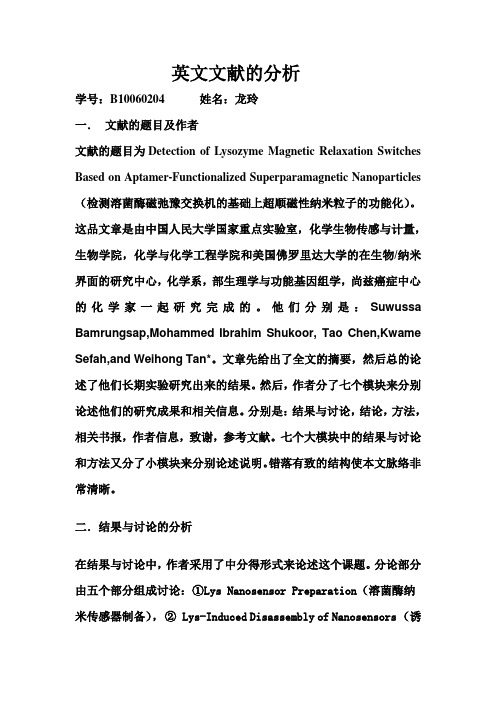
英文文献的分析学号:B10060204 姓名:龙玲一.文献的题目及作者文献的题目为Detection of Lysozyme Magnetic Relaxation Switches Based on Aptamer-Functionalized Superparamagnetic Nanoparticles (检测溶菌酶磁弛豫交换机的基础上超顺磁性纳米粒子的功能化)。
这品文章是由中国人民大学国家重点实验室,化学生物传感与计量,生物学院,化学与化学工程学院和美国佛罗里达大学的在生物/纳米界面的研究中心,化学系,部生理学与功能基因组学,尚兹癌症中心的化学家一起研究完成的。
他们分别是:Suwussa Bamrungsap,Mohammed Ibrahim Shukoor, Tao Chen,Kwame Sefah,and Weihong Tan*。
文章先给出了全文的摘要,然后总的论述了他们长期实验研究出来的结果。
然后,作者分了七个模块来分别论述他们的研究成果和相关信息。
分别是:结果与讨论,结论,方法,相关书报,作者信息,致谢,参考文献。
七个大模块中的结果与讨论和方法又分了小模块来分别论述说明。
错落有致的结构使本文脉络非常清晰。
二.结果与讨论的分析在结果与讨论中,作者采用了中分得形式来论述这个课题。
分论部分由五个部分组成讨论:①Lys Nanosensor Preparation(溶菌酶纳米传感器制备),② Lys-Induced Disassembly of Nanosensors (诱导溶菌酶分解纳米传感器),③ Selectivity and Specificity of Magnetic Nanosensors (磁性纳米传感器的选择性和特异性),④Quantitative Analysis(定量分析),⑤ Detection of Lys in Cell Lysates (细胞裂解液中溶菌酶的检测)。
阅读策略生物医学英文文献阅读策略与方法PPT课件
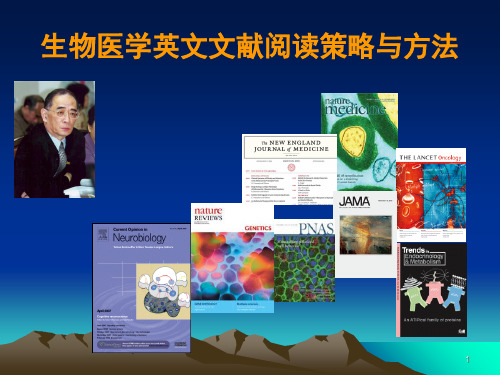
读者可在“新闻与观点”中 了解到他们自己的领域以及 其他领域中什么是最热门的 。这种文章必须将某一项成 果讲清楚,必须能让读者找 到一个兴奋点,然而 又必 须客观公正地对研究工作进 行评价,并与他人的研究工 作进行比较。这样的文章大 多数都是约稿
–Although elimination may be key to a healthy response to some microbes, a recent paper in Nature reports that regulatory T cells actually aid the survival of some intracellular parasites, which ensures a memory response.
固有免疫:对继承性免疫的影响
IL-12和 IL-23:固有免疫和继 承性免疫的关键调节因子
丙型肝炎病毒颠覆免疫应答: 超越免疫逃避的免疫调节策略
12
About Trends in Immunology
• Trends in Immunology publishes concise, lively and up-to-date articles that highlight advances in the diverse fields of immunology.
From Wikipedia, the free encyclopedia 9
综述 (Review or Review article)
•文献综述是旨在复习一个特定的 科学领域或科学问题当前知识的 关键点,包括新的科学发现及其 理论上和方法学贡献的一种文献 形式
•文献综述只是次生科学知识来源 ,并不报告任何新的或原始实验 结果
生物科学中英文对照外文翻译文献
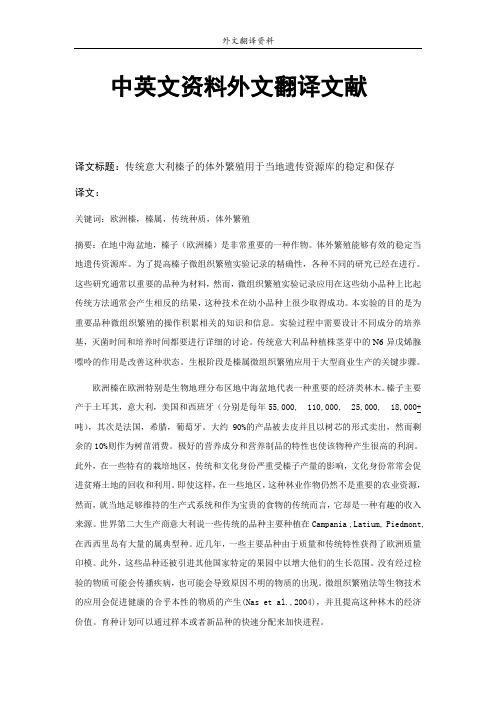
中英文资料外文翻译文献译文标题:传统意大利榛子的体外繁殖用于当地遗传资源库的稳定和保存译文:关键词:欧洲榛,榛属,传统种质,体外繁殖摘要:在地中海盆地,榛子(欧洲榛)是非常重要的一种作物。
体外繁殖能够有效的稳定当地遗传资源库。
为了提高榛子微组织繁殖实验记录的精确性,各种不同的研究已经在进行。
这些研究通常以重要的品种为材料,然而,微组织繁殖实验记录应用在这些幼小品种上比起传统方法通常会产生相反的结果,这种技术在幼小品种上很少取得成功。
本实验的目的是为重要品种微组织繁殖的操作积累相关的知识和信息。
实验过程中需要设计不同成分的培养基,灭菌时间和培养时间都要进行详细的讨论。
传统意大利品种植株茎芽中的N6-异戊烯腺嘌呤的作用是改善这种状态。
生根阶段是榛属微组织繁殖应用于大型商业生产的关键步骤。
欧洲榛在欧洲特别是生物地理分布区地中海盆地代表一种重要的经济类林木。
榛子主要产于土耳其,意大利,美国和西班牙(分别是每年55,000, 110,000, 25,000, 18,000+吨),其次是法国,希腊,葡萄牙。
大约90%的产品被去皮并且以树芯的形式卖出,然而剩余的10%则作为树苗消费。
极好的营养成分和营养制品的特性也使该物种产生很高的利润。
此外,在一些特有的栽培地区,传统和文化身份严重受榛子产量的影响,文化身份常常会促进贫瘠土地的回收和利用。
即使这样,在一些地区,这种林业作物仍然不是重要的农业资源,然而,就当地足够维持的生产式系统和作为宝贵的食物的传统而言,它却是一种有趣的收入来源。
世界第二大生产商意大利说一些传统的品种主要种植在Campania ,Latium, Piedmont,在西西里岛有大量的属典型种。
近几年,一些主要品种由于质量和传统特性获得了欧洲质量印模。
此外,这些品种还被引进其他国家特定的果园中以增大他们的生长范围。
没有经过检验的物质可能会传播疾病,也可能会导致原因不明的物质的出现。
微组织繁殖法等生物技术的应用会促进健康的合乎本性的物质的产生(Nas et al.,2004),并且提高这种林木的经济价值。
(英文)生物外文文献

FIG. 1
15.5%
FIG. 2
GRN knockdown reduced the mRNA expression of these genes, similar to the effects of STAT3 knockdown
58%
染色质免疫共沉淀技术( chromatin immunoprecipitation assay, CHIP )
• 皮尔森相关系数(Pearson correlation coefficient)也称皮尔森积矩 相关系数(Pearson product-moment correlation coefficient) ,是一种 线性相关系数。皮尔森相关系数是用来反映两个变量线性相关程 度的统计量。相关系数用r表示,其中n为样本量,分别为两个变 量的观测值和均值。r描述的是两个变量间线性相关强弱的程度。 r的绝对值越大表明相关性越强。
2.2倍
Indicate that in primary breast cancers, GRN expression specifically correlates with enhanced STAT3 transcriptional activity in the presence of tyrosine-phosphorylated STAT3
5
Suggesting that inhibiting GRN preferentially affects cells with activated STAT3 These findings suggest that the effect of granulin depletion is mediated by decreased STAT3 transcriptional activity.
生物科学论文中英文资料外文翻译文献
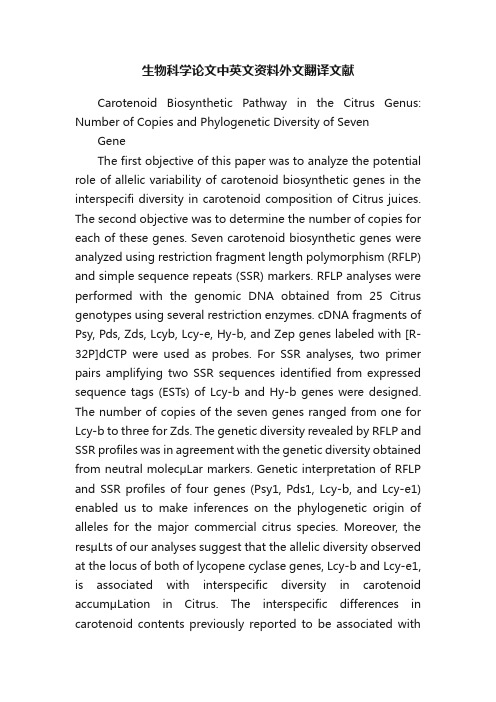
生物科学论文中英文资料外文翻译文献Carotenoid Biosynthetic Pathway in the Citrus Genus: Number of Copies and Phylogenetic Diversity of Seven GeneThe first objective of this paper was to analyze the potential role of allelic variability of carotenoid biosynthetic genes in the interspecifi diversity in carotenoid composition of Citrus juices. The second objective was to determine the number of copies for each of these genes. Seven carotenoid biosynthetic genes were analyzed using restriction fragment length polymorphism (RFLP) and simple sequence repeats (SSR) markers. RFLP analyses were performed with the genomic DNA obtained from 25 Citrus genotypes using several restriction enzymes. cDNA fragments of Psy, Pds, Zds, Lcyb, Lcy-e, Hy-b, and Zep genes labeled with [R-32P]dCTP were used as probes. For SSR analyses, two primer pairs amplifying two SSR sequences identified from expressed sequence tags (ESTs) of Lcy-b and Hy-b genes were designed. The number of copies of the seven genes ranged from one for Lcy-b to three for Zds. The genetic diversity revealed by RFLP and SSR profiles was in agreement with the genetic diversity obtained from neutral molecμLar markers. Genetic interpretation of RFLP and SSR profiles of four genes (Psy1, Pds1, Lcy-b, and Lcy-e1) enabled us to make inferences on the phylogenetic origin of alleles for the major commercial citrus species. Moreover, the resμLts of our analyses suggest that the allelic diversity observed at the locus of both of lycopene cyclase genes, Lcy-b and Lcy-e1, is associated with interspecific diversity in carotenoid accumμLation in Citrus. The interspecific differences in carotenoid contents previously reported to be associated withother key steps catalyzed by PSY, HY-b, and ZEP were not linked to specific alleles at the corresponding loci.KEYWORDS: Citrus; carotenoids; biosynthetic genes; allelic variability; phylogeny INTRODUCTIONCarotenoids are pigments common to all photosynthetic organisms. In pigment-protein complexes, they act as light sensors for photosynthesis but also prevent photo-oxidat ion induced by too strong light intensities. In horticμLtural crops, they play a major role in fruit, root, or tuber coloration and in nutritional quality. Indeed some of these micronutrients are precursors of vitamin A, an essential component of human and animal diets. Carotenoids may also play a role in chronic disease prevention (such as certain cancers), probably due to their antioxidant properties. The carotenoid biosynthetic pathway is now well established. Carotenoids are synthesized in plastids by nuclear-encoded enzymes. The immediate precursor of carotenoids (and also of gibberellins, plastoquinone, chlorophylls,phylloquinones, and tocopherols) is geranylgeranyl diphosphate (GGPP). In light-grown plants, GGPP is mainly derivedcarotenoid, 15-cis-phytoene. Phytoene undergoes four desaturation reactions catalyzed by two enzymes, phytoene desaturase (PDS) and β-carotene desaturase (ZDS), which convert phytoene into the red-colored poly-cis-lycopene. Recently, Isaacson et al. and Park et al. isolated from tomato and Arabidopsis thaliana, respectively, the genes that encode the carotenoid isomerase (CRTISO) which, in turn, catalyzes the isomerization of poly-cis-carotenoids into all-trans-carotenoids. CRTISO acts on prolycopene to form all-trans lycopene, which undergoes cyclization reactions. Cyclization of lycopene is abranching point: one branch leads to β-carotene (β, β-carotene) and the other toα-carotene (β, ε-carotene). Lycopene β-cyclase (LCY-b) then converts lycopene intoβ-carotene in two steps, whereas the formation of α-carotene requires the action of two enzymes, lycopene ε- cyclase (LCY-e) and lycopene β-cyclase (LCY-b). α- carotene is converted into lutein by hydroxylations catalyzed by ε-carotene hydroxylase (HY-e) andβ-carotene hydroxylase (HY-b). Other xanthophylls are produced fromβ-carotene with hydroxylation reactions catalyzed by HY-b and epoxydation catalyzed by zeaxanthin epoxidase (ZEP). Most of the carotenoid biosynthetic genes have been cloned and sequenced in Citrus varieties . However, our knowledge of the complex regμLation of carotenoid biosynthesis in Citrus fruit is still limited. We need further information on the number of copies of these genes and on their allelic diversity in Citrus because these can influence carotenoid composition within the Citrus genus.Citrus fruit are among the richest sources of carotenoids. The fruit generally display a complex carotenoid structure, and 115 different carotenoids have been identified in Citrus fruit. The carotenoid richness of Citrus flesh depends on environmental conditions, particμLarly on growing conditions and on geogr aphical origin . However the main factor influencing variability of caro tenoid quality in juice has been shown to be genetic diversity. Kato et al. showed that mandarin and orange juices accumμLated high levels of β-cryptoxanthin and violaxanthin, respectively, whereas mature lemon accumμLated extremely low levels of carotenoids. Goodner et al. demonstrated that mandarins, oranges, and their hybrids coμLd be clearly distinguished by theirβ-cryptoxanthin contents. Juices of red grapefruit contained two major carotenoids: lycopene and β-carotene. More recently, we conducted a broad study on the organization of the variability of carotenoid contents in different cμLtivated Citrus species in relation with the biosynthetic pathway . Qualitative analysis of presence or absence of the different compounds revealed three main clusters: (1) mandarins, sweet oranges, and sour oranges;(2) citrons, lemons, and limes; (3) pummelos and grapefruit. Our study also enabled identification of key steps in the diversification of the carotenoid profile. Synthesis of phytoene appeared as a limiti ng step for acid Citrus, while formation of β-carotene and R-carotene from lycopene were dramatically limited in cluster 3 (pummelos and grapefruit). Only varieties in cluster 1 were able to produce violaxanthin. In the same study , we concluded that there was a very strong correlation between the classification of Citrus species based on the presence or absence of carotenoids (below,this classification is also referred to as the organization of carotenoid diversity) and genetic diversity evaluated with bi ochemical or molecμLar markers such as isozymes or randomLy amplified polymorphic DNA (RAPD). We also concluded that, at the interspecific level, the organization of the diversity of carotenoid composition was linked to the global evolution process of cμLt ivated Citrus rather than to more recent mutation events or human selection processes. Indeed, at interspecific level, a correlation between phenotypic variability and genetic diversity is common and is generally associated with generalized gametic is common and is generally associated with generalized gametic disequilibrium resμLting from the history of cμLtivated Citrus. Thus from numerical taxonomy based on morphologicaltraits or from analysis of molecμLar markers , all authors agreed on the existence o f three basic taxa (C. reticμLata, mandarins; C. medica, citrons; and C. maxima, pummelos) whose differentiation was the resμLt of allopatric evolution. All other cμLtivated Citrus specie s (C. sinensis, sweet oranges; C. aurantium, sour oranges;C. paradi si, grapefruit; and C. limon, lemons) resμLted from hybridization events within this basic pool except for C. aurantifolia, which may be a hybrid between C. medica and C. micrantha .Our p revious resμLts and data on Citrus evolution lead us to propose the hypothesis that the allelic variability supporting the organization of carotenoid diversity at interspecific level preceded events that resμLted in the creation of secondary species. Such molecμLar variability may have two different effects: on the one hand, non-silent substitutions in coding region affect the specific activity of corresponding enzymes of the biosynthetic pathway, and on the other hand, variations in untranslated regions affect transcriptional or post-transcriptional mechanisms.There is no available data on the allelic diversity of Citrus genes of the carotenoid biosynthetic pathway. The objective of this paper was to test the hypothesis that allelic variability of these genes partially determines phenotypic variability at the interspecific level. For this purpose, we analyzed the RFLPs around seven genes of the biosynthetic pathway of carotenoids (Psy, Pds, Zds, Lcy-b, Lcy-e, Hy-b, Zep) and the polymorphism of two SSR sequences found in Lcy-b and Hy-b genes in a representative set of varieties of the Citrus genus already analyzed for carotenoid constitution. Our study aimed to answer the following questions: (a) are those genes mono- or mμLtilocus, (b) is the polymorphism revealed by RFLP and SSR markers inagreement with the general histor y of cμLtivated Citrus thus permitting inferences about the phylogenetic origin of genes of the secondary species, and (c) is this polymorphism associated with phenotypic (carotenoid compound) variations.RESΜLTS AND DISCUSSIONGlobal Diversity of the Genotype Sample Observed by RFLP Analysis. RFLP analyses were performed using probes defined from expressed sequences of seven major genes of the carotenoid biosynthetic pathway . One or two restriction enzymes were used for each gene. None of these enzymes cut the cDNA probe sequence except HindIII for the Lcy-e gene. Intronic sequences and restriction sites on genomic sequences werescreened with PCR amplification using genomic DNA as template and with digestion of PCR products. The resμLts indicated the absence of an intronic sequence for Psy and Lcy-b fragments. The absence of intron in these two fragments was checked by cloning and sequencing corresponding genomic sequences (data not shown). Conversely, we found introns in Pds, Zds, Hy-b, Zep, and Lcy-e genomic sequences corresponding to RFLP probes. EcoRV did not cut the genomic sequences of Pds, Zds, Hy-b, Zep, and Lcy-e. In the same way, no BamHI restriction site was found in the genomic sequences of Pds, Zds, and Hy-b. Data relative to the diversity observed for the different genes are presented in Table 4. A total of 58 fragments were identified, six of them being monomorphic (present in all individuals). In the limited sample of the three basic taxa, only eight bands out of 58 coμLd not be observed. In the basic taxa, the mean number of bands per genotype observed was 24.7, 24.7, and 17 for C. reticμLata, C. maxima, and C. medica, respectively. It varies from28 (C. limettioides) to 36 (C. aurantium) for the secondary species. The mean number of RFLP bands per individual was lower for basic taxa than for the group of secondary species. This resμLt indicates that secondary species are much more heterozygous than the basic ones for these genes, which is logical if we assume that the secondary species arise from hybridizations between the three basic taxa. Moreover C. medica appears to be the least heterozygous taxon for RFLP around the genes of the carotenoid biosynthetic pathway, as already shown with isozymes, RAPD, and SSR markers.The two lemons were close to the acid Citrus cluster and the three sour oranges close to the mandarins/sweet oranges cluster. This organization of genetic diversity based on the RFLP profiles obtained with seven genes of the carotenoid pathway is very similar to that previously obtained with neutral molecμLar markers such as genomic SSR as well as the organization obtained with qualitative carotenoid compositions. All these resμLts suggest that the observed RFLP and SSR fragments are good phylogenetic markers. It seems consistent with our basic hypothesis that major differentiation in the genes involved in the carotenoid biosynthetic pathway preceded the creation of the secondary hybrid species and thus that the allelic structure of these hybrid species can be reconstructed from alleles observed in the three basic taxa.Gene by Gene Analysis: The Psy Gene. For the Psy probe combined with EcoRV or BamHI restriction enzymes, five bands were identified for the two enzymes, and two to three bands were observed for each genotype. One of these bands was present in all individuals. There was no restriction site in the probe sequence. These resμLts lead us to believe that Psy is present at two loci,one where no polymorphism was found with the restriction enzymes used, and one that displayed polymorphism. The number of different profiles observed was six and four with EcoRV and BamHI, respectively, for a total of 10 different profiles among the 25 individuals .Two Psy genes have also been found in tomato, tobacco, maize, and rice . Conversely, only one Psy gene has been found in Arabidopsis thaliana and in pepper (Capsicum annuum), which also accumμLates carotenoids in fruit. According to Bartley and Scolnik, Psy1 was expressed in tomato fruit chromoplasts, while Psy2 was specific to leaf tissue. In the same way, in Poaceae (maize, rice), Gallagher et al. found that Psy gene was duplicated and that Psy1 and notPsy2 transcripts in endosperm correlated with endosperm carotenoid accumμLation. These resμLts underline the role of gene duplication and the importance of tissue-specific phytoene synthase in the regμLation of carotenoid accumμLation.All the polymorphic bands were present in the sample of the basic taxon genomes. Assuming the hypothesis that all these bands describe the polymorphism at the same locus for the Psy gene, we can conclude that we found allelic differentiation between the three basic taxa with three alleles for C. reticμLata, four for C. maxima, and one for C. medica.The alleles observed for the basic taxa then enabled us to determine the genotypes of all the other species. The presumed genotypes for the Psy polymorphic locus are given in Table 7. Sweet oranges and grapefruit were heterozygous with one mandarin and one pummelo allele. Sour oranges were heterozygous; they shared the same mandarin allele with sweet oranges but had a different pummelo allele. Clementine was heterozygous with two mandarin alleles; one shared with sweetoranges and one with “Willow leaf” mandarin. “Meyer” lemon was heterozygous, with the mandarin allele also found in sweet oranges, and the citron allele. “Eureka”lemon was also heterozygous with the same pummelo allele as sour oranges and the citron allele. The other acid Citrus were homozygous for the citron allele.The Pds Gen. For the Pds probe combined with EcoRV, six different fragments were observed. One was common to all individuals. The number of fragments per individual was two or three. ResμLts for Pds led us to believe that this gene is present at two loci, one where no polymorphism was found with EcoRV restriction, and one displaying polymorphism. Conversely, studies on Arabidopsis, tomato, maize, and rice showed that Pds was a single copy gene. However, a previous study on Citrus suggests that Pds is present as a low-copy gene family in the Citrus genome, which is in agreement with our findings.The Zds Gene. The Zds profiles were complex. Nine and five fragments were observed with EcoRV and BamHI restriction, respectively. For both enzymes, one fragment was common to all individuals. The number of fragments per individual ranged from two to six for EcoRV and three to five for BamHI. There was no restriction site in the probe sequence. It can be assumed that several copies (at least three) of the Zds gene are present in the Citrus genome with polymorphism for at least two of them. In Arabidopsis, maize, and rice, like Pds, Zds was a single-copy gene .In these conditions and in the absence of analysis of controlled progenies, we are unable to conduct genetic analysis of profiles. However it appears that some bands differentiated the basic taxa: one for mandarins, one for pummelos, and one for citrons with EcoRV restriction and one for pummelos and onefor citrons with BamHI restriction. Two bands out of the nine obtained with EcoRV were not observed in the samples of basic taxa. One was rare and only observed in “Rangpur” lime. The other was found in sour oranges, “V olkamer” lemon,and “Palestine sweet” lime suggesting a common ancestor for these three genotypes.This is in agreement with the assumption of Nicolosi et al. that “V olkamer” lemon resμLts from a complex hybrid combination with C. aurantium as one parent. It will be necessary to extend the analysis of the basic taxa to conclude whether these specific bands are present in the diversity of these taxa or resμLt from mutations after the formation of the secondary species.The Lcy-b Gene with RFLP Analysis.After restriction with EcoRV and hybridization with the Lcy-b probe, we obtained simple profiles with a total of four fragments. One to two fragments were observed for each individual, and seven profiles were differentiated among the 25 genotypes. These resμLts provide evidence that Lcy-b is present at a single locus in the haploid Citrus genome. Two lycopene β-cyclases encoded by two genes have been identified in tomato. The B gene encoded a novel type of lycopene β-cyclase whose sequence was similar to capsanthin-capsorubin synthase. The B gene expressed at a high level in βmutants was responsible for strong accumμLation ofβ-carotene in fruit, while in wild-type tomatoes, B was expressed at a low level.The Lcy-b Gene with SSR Analysis. Four bands were detected at locus 1210 (Lcy-b gene). One or two bands were detected per variety confirming that this gene is mono locus. Six different profiles were observed among the 25 genotypes. As with RFLPanalysis, no intrataxon molecμLar polymorphism was found within C. Paradisi, C. Sinensis, and C. Aurantium.Taken together, the information obtained from RFLP and SSR analyses enabled us to identify a complete differentiation among the three basic taxon samples. Each of these taxons displayed two alleles for the analyzed sample. An additional allele was identified for “Mexican” l ime. The profiles for all secondary species can be reconstructed from these alleles. Deduced genetic structure is given in. Sweet oranges and clementine were heterozygous with one mandarin and one pummelo allele. Sour oranges were also heterozygous sharing the same mandarin allele as sweet oranges but with another pummelo allele. Grapefruit were heterozygous with two pummelo alleles. All the acid secondary species were heterozygous, having one allele from citrons and the other one from mandarins except for “Mexican” lime, which had a specific allele.柑桔属类胡萝卜素生物合成途径中七个基因拷贝数目及遗传多样性的分析摘要:本文的首要目标是分析类胡萝卜素生物合成相关等位基因在发生变异柑橘属类胡萝卜素组分种间差异的潜在作用;第二个目标是确定这些基因的拷贝数。
LiteratureReport生物专业原全英文文献汇报PPT教案
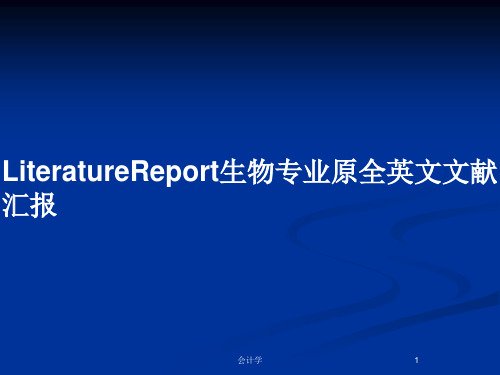
3. Results
3.3. Screening for single-copy transformants
(1)In this study single insertion transformants, generated by gene replacement of the AOX1 gene, was preferred, as this type of transformants is relatively easily screened for, and multiple insertion events rarely take place.
(2) YPD medium (1% (w/v) yeast extract, 2% (w/v) peptone, 2% (w/v) dextrose) YNB (Yeaum sulphate without amino acids) BMSY media
2. Materials and methods
2.3. Preparation of competent cells
(1) Conduct the step of this experiment according to the procedure of this paper.
第一次英文文献精读讲述讲解

从植物种子中提取油的脂肪酸和甾醇的组成以及抗氧化活性文章信息文章历史:收到2015年10月1日收到修订后的表格2016年6月21日接受2016年6月29日在2016年6月30日可用摘要本研究确定并比较了用正己烷(索氏法)和氯仿/甲醇(Folch法)从香菜,葛缕子籽,茴香,肉豆蔻和白芥菜籽提取的植物种子油中生物活性成分的含量。
在肉豆蔻和茴香籽油不饱和脂肪酸主要是油酸,而岩芹酸存在于香菜和葛缕子油中。
关于甾醇,用这两种方法提取的种子油中的主要组分是β-谷甾醇。
用氯仿/甲醇萃取的肉豆蔻,白芥和香菜籽油的总酚含量比用正己烷制备它们的对应物中更高。
根据Folch方法提取的种子油样表现出比用索氏方法制备的油样清除DPPH自由基的能力更高。
用Folch方法生产的油的甲醇提取物的DPPH 值也高于用正己烷萃取的油。
关键词:植物种子油;脂肪酸;甾醇;酚类化合物;DPPH;索氏法;Folch方法1、引言脂质是人类饮食的主要成分。
在世界许多地区分布的植物种子中它们被大量的发现。
他们可以提供给油高浓度的单不饱和脂肪酸,通过几种机制可以预防心血管疾病(López-Miranda等,2006)。
他们是清除体内产生自由基的酚类化合物的一个良好来源。
通过激活内源性防御系统和调节细胞信号传导过程多酚也可以提供间接的保护(Chen,Yu,Owuor,&Kong,2000)。
酚类抗氧化剂存在于香料和草药中作为食品添加剂使用可以防止脂质氧化和颜色变化,风味和食品的营养品质(Kozłowska,Zbikowska,Gruczyn _'ska,Zontała,&Półtorak,2014 _)。
甾醇是植物种子油的其他重要成分其显示了降低血清胆固醇的性质和有效的抗氧化剂。
它们的抗氧化活性归因于形成烯丙基自由基,其经历异构化到其他相对稳定的自由基(Ramadan &Moersel,2006)。
最常见的植物甾醇(植物甾醇)是β-谷甾醇,菜油甾醇,豆甾醇和燕麦甾醇。
英文文献讲解
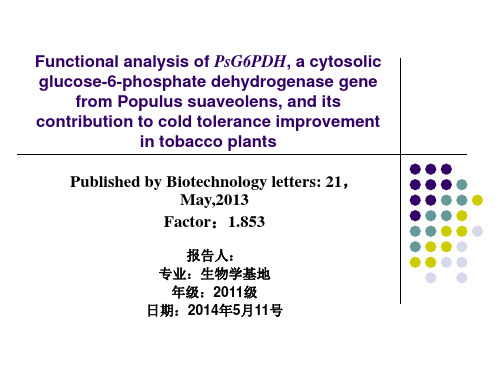
Up-regulated
结论
甜杨PsG6PDH的组成性表达,不会影响 烟草的表型生长,而且在低温胁迫下可 以提高烟草的抗寒能力。因此,可作为 植物抗寒冻遗传改良的新的外源基因。
前景展望
1.由于植物抗寒冻性状受多基因控制,因此有必要从 多基因的作用层次上来探讨植物抗寒冻的作用机制。 2.采用生物信息学技术设计甜杨G6PDH基因的突变 体,研究G6PDH突变体及其活性,以及在转基因植 物中的抗性作用。经过改造可能会获得活性更强的 G6PDH。
背景介绍
甜杨中分离G6PDH基因
生物学分析
该基因可能编码胞质PsG6PDH 而且与基因胁迫有关
PsG6PDH的原核表达
验证了其编码框的完整性
导入烟草进行表达和分析
对其功能进行进一步鉴定
实验部分
实验部分
甜杨 高效稳定的离体培养体系的建立 总RNA的提取 基因组DNA的制备
G6PDH基因的分离和克隆
感谢大家的聆听!
(1)未经15℃低温驯化:培养温度直接从25 ℃下降 到4 ℃,每隔12h观察烟草的表型变化(结果如图Fig.4.a)
(2)经15 ℃低温驯化:培养温度先降至15 ℃后缓慢
下降到-4 ℃,按0.5 ℃/h逐步降低温度,在每处理温 度下24h,观察烟草的表型变化(结果如图Fig.4.b)
结果与讨论
(a). Without cold-acclimation
30 days old,将植株转入土壤,在植物培养箱 中under 15%,a 16/8h light/dark photoperiod for 1 month。 Used for cold tolerance assays and gene expression analyses
生物论文英文总结范文
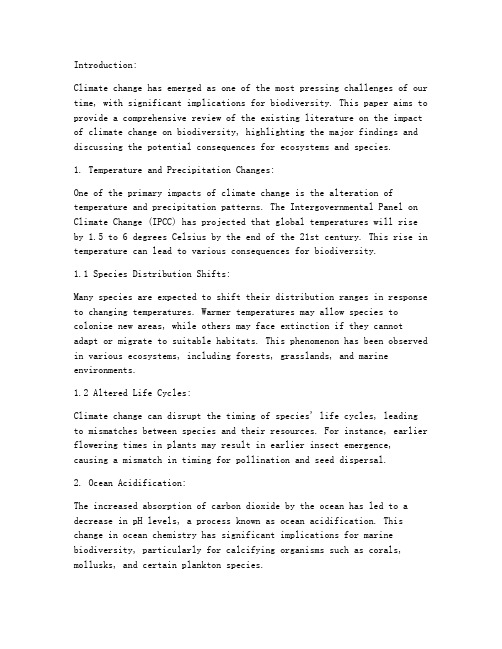
Introduction:Climate change has emerged as one of the most pressing challenges of our time, with significant implications for biodiversity. This paper aims to provide a comprehensive review of the existing literature on the impact of climate change on biodiversity, highlighting the major findings and discussing the potential consequences for ecosystems and species.1. Temperature and Precipitation Changes:One of the primary impacts of climate change is the alteration of temperature and precipitation patterns. The Intergovernmental Panel on Climate Change (IPCC) has projected that global temperatures will rise by 1.5 to 6 degrees Celsius by the end of the 21st century. This rise in temperature can lead to various consequences for biodiversity.1.1 Species Distribution Shifts:Many species are expected to shift their distribution ranges in response to changing temperatures. Warmer temperatures may allow species to colonize new areas, while others may face extinction if they cannot adapt or migrate to suitable habitats. This phenomenon has been observed in various ecosystems, including forests, grasslands, and marine environments.1.2 Altered Life Cycles:Climate change can disrupt the timing of species' life cycles, leading to mismatches between species and their resources. For instance, earlier flowering times in plants may result in earlier insect emergence, causing a mismatch in timing for pollination and seed dispersal.2. Ocean Acidification:The increased absorption of carbon dioxide by the ocean has led to a decrease in pH levels, a process known as ocean acidification. This change in ocean chemistry has significant implications for marine biodiversity, particularly for calcifying organisms such as corals, mollusks, and certain plankton species.2.1 Coral Bleaching:Ocean acidification has been linked to the occurrence of coral bleaching events, where corals expel the algae living in their tissues, resulting in a loss of color. This phenomenon can lead to reduced coral cover, affecting the diversity and functioning of coral reef ecosystems.2.2 Shell Formation and Growth:Ocean acidification can also hinder the shell formation and growth of calcifying organisms, potentially leading to reduced population sizes and altered community structures.3. Habitat Loss and Fragmentation:Climate change-induced changes in temperature, precipitation, and sea-level rise can lead to habitat loss and fragmentation, further impacting biodiversity.3.1 Forests:Many forest ecosystems are at risk of habitat loss due to changing climate conditions. Deforestation, combined with climate change, can exacerbate the loss of biodiversity, particularly in tropical regions.3.2 Mountainous Areas:Mountainous areas are particularly vulnerable to climate change, as warming temperatures can lead to the melting of glaciers and the loss of alpine habitats. This can result in the extinction of species adapted to specific mountainous environments.Conclusion:In conclusion, climate change has significant implications for biodiversity, with various direct and indirect effects on species and ecosystems. The alterations in temperature, precipitation, ocean chemistry, and habitat availability can lead to species distribution shifts, altered life cycles, habitat loss, and fragmentation. Understanding the complex interactions between climate change and biodiversity is crucial for developing effective conservation strategiesand mitigating the potential consequences of climate change on our planet's ecosystems.。
生物学英文文献检索介绍
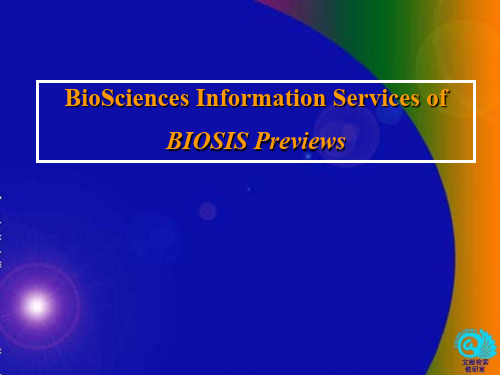
现在词的中间,也可出现在词的右端,如wom#n表示
可检索woman和women; “?” 代表任单个字母,也可以代表空字母, 如colo?r表示可检索color和colour
$运算
截词检索举例
#运算
截词检索举例
$运算检索 结果
$,#,?符号检索结果
D. 逻辑检索式,可达到用户较为复杂的 检索目的 and ,or ,not,其中 and 和 or也可使用combine栏位
3. Scope Note(标题或关键字说明):
可查阅主题词的生物学分类号及应用范围 4. Explode(扩展): 同时检索主题词及其下位词。
(三)字段限制检索
点击图标,进入字 段限制检索
输入关键词,选择相应字段进行检索
先输入关键词 再选择相应字段
,然后点击Perform search
(四)自由词检索方法和技巧
检索词输入框
限制项
工具列说明
作者 查询 刊名 查询 工具 查询 限制 检索 更换数 据库
退出
检索 模式 逻辑 检索 篇名 检索 字段 检索
(一) 基本检索模式
系统默认的检索是关键词检索,在输入框中输入关键词,点击 如果勾了map term to subject heading,则进入建议选词状态 . 检索
Subject Coverage
• Related areas 包括
– Methods (研究方法) – Iቤተ መጻሕፍቲ ባይዱstrument (实验仪器)
第二部分 OVID版Biosis Previews
链接到馆藏 链接到文摘
一、BIOSIS BP的数据结构
AU 作者/编者/发明 人 AN/UI存取号 IN 单位、机构 版权信息
中学生物 实验教学 英文文献
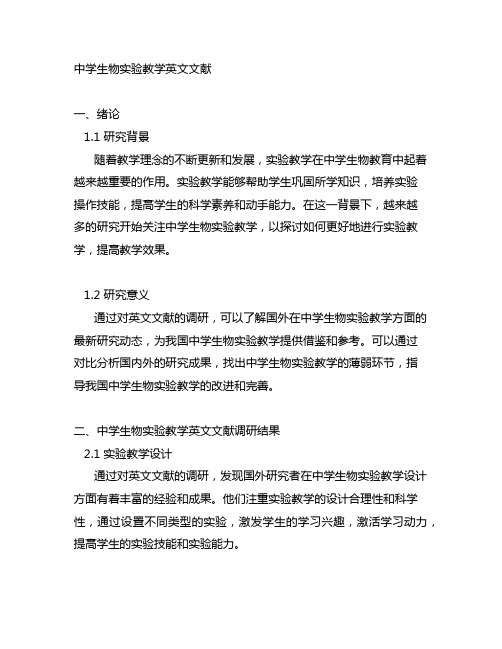
中学生物实验教学英文文献一、绪论1.1 研究背景随着教学理念的不断更新和发展,实验教学在中学生物教育中起着越来越重要的作用。
实验教学能够帮助学生巩固所学知识,培养实验操作技能,提高学生的科学素养和动手能力。
在这一背景下,越来越多的研究开始关注中学生物实验教学,以探讨如何更好地进行实验教学,提高教学效果。
1.2 研究意义通过对英文文献的调研,可以了解国外在中学生物实验教学方面的最新研究动态,为我国中学生物实验教学提供借鉴和参考。
可以通过对比分析国内外的研究成果,找出中学生物实验教学的薄弱环节,指导我国中学生物实验教学的改进和完善。
二、中学生物实验教学英文文献调研结果2.1 实验教学设计通过对英文文献的调研,发现国外研究者在中学生物实验教学设计方面有着丰富的经验和成果。
他们注重实验教学的设计合理性和科学性,通过设置不同类型的实验,激发学生的学习兴趣,激活学习动力,提高学生的实验技能和实验能力。
2.2 实验教学方法另外,英文文献中也提到了国外在中学生物实验教学方法上的创新和改革。
他们注重通过多元化的实验教学方法,如课堂讨论、小组合作、实验研究等,促进学生自主探究和合作学习,提高学生的探究精神和实验技能。
2.3 实验教学评价英文文献还对国外在中学生物实验教学评价方面的研究成果进行了总结和归纳。
他们倡导运用多元化的评价方法,如实验报告、实验成绩、实验表现、实验心得等,全面客观地评价学生的实验能力和实验素养。
三、中学生物实验教学英文文献研究存在的问题3.1 研究热点不明显尽管国外在中学生物实验教学方面有着不少的研究成果,但是整体而言,研究热点不够突出,缺乏前沿性和创新性。
目前国外的研究多集中在实验教学设计、实验教学方法和实验教学评价等方面,缺乏对实验教学理论和实践的深入探讨和研究。
3.2 实验教学成果转化率低国外的研究成果在实践中的转化率并不高。
由于文化和教育体系的差异,一些国外的实验教学理论和方法并不完全适用于我国的中学生物实验教学。
PNAS生物英文文献分享
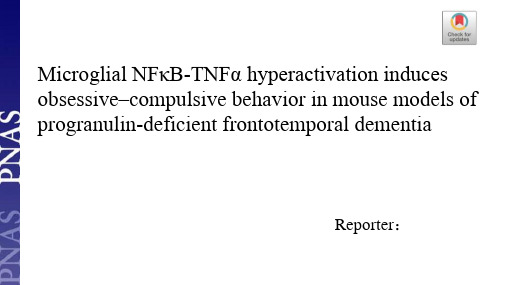
Methods
Patient Behavior and Voxel-Based Morphometry Analyses.
Electrophysiological Recordings Behavior Tests In Vivo Imaging Quantifying Microglial Chemotaxis. Blood and Spleen Cell Harvest. Isolation of Microglia from Adult Mouse Brain. Quantitative Real-Time PCR. Primary Mouse Microglia ProteinExtractionandELISAs Immunohistochemistry. NF-κB Reporter Assay. Statistical Analysis.
Microglial NFκB-TNFα hyperactivation induces obsessive–compulsive behavior in mouse models of progranulin-deficient frontotemporal dementia
Reporter:
Background
理毛行为(grooming behavior) 是指动物个体对其本身或对同种其他个体身体表面(毛发、皮肤或羽毛) 各
种形式的照看和关注,包括对身体表面有条理的梳理,有时也用嘴唇和舌头舔毛发和皮肤。在此基础上,Pérez et al . 提出理毛行为是通过观察或接触对身体表面的一个或多个位点近距离探查,同时分开毛发捡出盐粒和皮肤寄 生物,这一定义被多数学者广泛接受。 理毛行为可分为:自我理毛(autogrooming) 和相互理毛(allogrooming),自我理毛(autogrooming) 多用于研 究抑郁、焦虑、恐惧或躯体不适对个体行为的影响;相互理毛除对上述问题研究外,还可观察动物的社会行为。
生物英文文献介绍
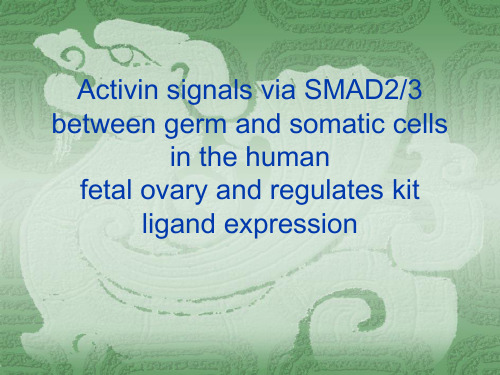
Thirdly, SMADs2 and 3 were also localised to the nuclei of pre-granulosa cells surrounding oocytes that had formed (or were in the process of forming) primordial follicles (Figs. 2C and F). No expression was seen in oocytes at any developmental stage.
We have made use of this in the present study to identify the cells in the developing human ovary which respond to and mediate the effects of activin on germ cell survival. Furthermore we identify kit ligand (KITLG),a key regulator of mammalian ovarian development, as a target of activinregulated transcriptional repression in the human fetal ovary.
SMAD2 and 3 proteins in human fetal ovary
Immunoblotting demonstrated the expression of SMAD2/3 and phosphorylated SMAD2/3 proteins in the mid-trimester human fetal ovary (Fig. 1C).
生物系列小短文(一)Thediversityoflife解读

生物系列小短文(一)The diversity of lifeBiodiversity(生物多样性) is the totality of genes(基因),species (物种), and ecosystems (生态系统)in a region.Thewealth of life on earth today is the product of hundreds of millions of yearsof evolutionary(进化的) history. Over the courseof time, human cultures have emerged and adapted to the local environment,discovering, using, and altering local biotic resources (生物资源).Manyareas that now seem "natural" bear the marks of millennia of humanhabitation, crop cultivation(耕作),and resource harvesting(收获).The domestication(驯养)and breeding(饲养) of local varieties ofcrops and livestock have further shaped biodiversity.Biodiversitycan be divided into hierarchical categories that describe quite differentaspects of living systems that scientists measure in different ways.Geicdiversity(遗传多样性)Geic diversity refers to the variation ofgenes within species.This covers distinct populations of the same species (such asthethousands of traditional rice varieties in India) or geicvariation within apopulation (which is very high among Indianrhinos(犀牛), for example, and very low among cheetahs(印度豹)).Until recently, measurements of geic diversity were appliedmainly todomesticated species and populations held in zoos orbotanic gardens, butincreasingly the techniques are beingapplied to wild species."Each species is the repository of an immense amount ofgeicinformation," writes E. O.Wilson in Biodiversity (1988.Washington, DC: National AcademyPress). "The number of genesrange from about 1,000 in bacteria and 10,000in some fungi to700,000 or more in many flowering plants and a few animals.Atypical mammal such as the house mouse has about 100,000genes. ...If stretchedout fully, the DNA would be roughly one meter long. But this molecule isinvisible to the nakedeye. ...The full information contained therein, iftranslated into ordinary-size letter of printed text, would just about fillall15 editions of the Encyclopedia Britannica published since 1768."Species diversity(物种多样性)Species diversity refers to the variety ofspecies within a region.Such diversity can be measured in many ways, and scientists have notsettled on a single best method. The number of species in a region -- its"species richness"-- is one often-used measure, but a more precise measurement, "taxonomicdiversity," also considers the relationship of species to each other.For example, an island with two species of birds and one species of lizardhas greater taxonomic diversity than an island with three species of birds butno lizards.Thus, even though there may be more species of beetles on earth than allother species combined, they do not account for the greater part of speciesdiversity because they are so closely related.Similarly, many more species live on land than in the sea, but terrestrialspecies are more closely related to each other than ocean species are, sodiversity is higher in marine ecosystems than a strict count of species wouldsuggest.Estimates of global species diversity havevaried from 2 million to 100 million species, with a best estimate of somewherenear 10 million, and only 1.4 million have actually been named.New species are still beingdiscovered--even new birds and mammals. On average, about three new species ofbirds are found each year, and as recently as 1990, a new species of monkey wasdiscovered. Other vertebrate groups are still far from being completelydescribed: an estimated 40 percent of freshwater fishes in South America havenot yet been classified.Ecosystemdiversity(生态系统多样性)Ecosystem diversity is harder to measure than species or geic diversity because the"boundaries" of communities(群落) -- associations of species -- and ecosystems areelusive.Nevertheless, as long as a consistent set of criteriaisused to define communities and ecosystems, their number and distribution can bemeasured.Until now, such schemes have been applied mainlyatnational and sub-national levels, though some coarseglobal classificationshave been made.Besides ecosystem diversity, many other expressionsofbiodiversity can be important. These include:o the relative abundance ofspecies,o the age structure of populations,o the pattern of communities in aregion,o changes in community compositionand structure over time, ando ecological processes aspredation, parasitism, and mutualism.More generally, to meet specific managementor policygoals, it is often important toexamine not only compositional diversity --genes, species, and ecosystems -- but alsodiversity in ecosystem structure andfunction.For individuals and populations, theseinteractions include suchmechanisms as:predation(捕食),competition(竞争),parasitism(寄生), and mutualism(共生)while communities changethrough the processof succession. In yet another type ofinteraction, speciesinfluence their physicalenvironment--whether through primary production(初级生产者) (the transformationof solar energy to biomass through photosynthesis(光合作用)), decomposition(分解) (thebreakdown of organic materialsby organisms in the environment), or participation in(参与) biogeochemicalcycles (the movement of nutrients, water, and otherchemical elements through living organisms and the physical environment).Cultural diversity(文化多样性)Human culturaldiversity could also beconsidered part of biodiversity.Like geic or species diversity, some attributes of human cultures (say,nomadism or shiftingcultivation) represent "solutions" totheproblems of survival in particularenvironments.And, like other aspects of biodiversity,cultural diversity helps peopleadapt tochanging conditions.Cultural diversity is manifested bydiversity in language, religiousbeliefs,land-management practices, art, music,social structure, cropselection, diet,and any number of other attributes ofhuman society.</div。
- 1、下载文档前请自行甄别文档内容的完整性,平台不提供额外的编辑、内容补充、找答案等附加服务。
- 2、"仅部分预览"的文档,不可在线预览部分如存在完整性等问题,可反馈申请退款(可完整预览的文档不适用该条件!)。
- 3、如文档侵犯您的权益,请联系客服反馈,我们会尽快为您处理(人工客服工作时间:9:00-18:30)。
C2C12:小鼠附,24、48、72h:定量检测细胞增殖
在不同基底硬度上未分化的成肌细胞在PCL 膜上的增殖和粘附 基底硬度对成肌细胞分化的影响 细胞融合是成肌细胞分化的基本条件 生化信号对成肌细胞的分化十分重要
Undifferentiated myoblasts functionally adhere to PCL films
Feeder layer systems. C2C12 cells pre-stained with redVybrantTMvital dye were cultured directly over a feeder layer ofnon-proliferating MYB01, MEF and NHDF in 3 distinct co-culture systems
研究背景 紧密连接 细胞与生物材料表面的附着是一个复杂过程,包括细 粘着带 胞的初期粘附、铺展、细胞骨架组装、黏着斑的形成和细 粘着连接 胞外基质的分泌和重组。细胞的粘附过程和细胞信号传导 通路有关,黏着斑和细胞骨架的形成是成熟细胞信号传导 黏着斑 细胞连接 斑块连接 的前提。黏着斑是一组胞浆内蛋白质形成的复合物。整合 素与细胞外基质结合,再与黏着斑形成复合物,传导细胞 外基质以及生长因子的信号,引起细胞骨架的变化,继而 桥粒连接 引起细胞的形态和一系列功能变化。 间隙连接(动物) 通讯连接 胞间连丝(植物)
AlamarBlue® 定量分析细胞增殖状况
免疫荧光染色和共聚焦显微镜观察细胞形态 、骨架和蛋白质表达
Properties of cross-linked PCL films
Effect of substrate stiffness on myoblast adhesion and proliferation
MyoD expression in myoblasts cultured on PCL films
Myotube formation occurred only on upper layer of cells
Graphical representation of the feeder-layer setup
实验结论
01 02 03
基底的硬度对细胞分化起着重要作用
成肌细胞更易在软基质上分化
生物因子和细胞间接触对细胞成熟起着关 键作用,但生物分子的作用方式有待阐明
黏着斑的结构和功能
细胞的力学信号转导以这一结构网络为载体,其特殊的性质和 作用方式赋予了这种转导方式如下特点:其一,骨架网络具有对细胞内外应力进 行传递和分散的作用,而应力分布呈现的区域化特征,使细胞不同区域相关信号 强度不均一;其二,骨架网络在传递细胞内外应力的过程中,通过胞内外骨架协 同重组可对外力进行平衡,最终使骨架动力学变化整合为细胞张力水平,细胞张 力水平变化又可通过对胞内信号分子的活性调控,而影响细胞行为的各个方面; 其三,因许多酶和控制蛋白质合成、能量转换及细胞生长的物质都是以物理方式 被固定在细胞支架上,因此改变细胞的几何形状和骨架受力状态就可影响胞内信 号分子的活性,使细胞即时做出响应,故细胞力学信号的直接传递作用应快于对生 化信号的响应。
SCIENCE AND TECHNOLOGY OF ADVANCED MATERIALS Volume 13(6) nov 13, 2012 IF=3.752 SCI 分区:SCI 2区 汇报人:田洁 2013年12月10日
材料和方法
1 2 3 4
制备四种不同硬度的聚已内酯膜(PCL)
培养大鼠成肌细胞、小鼠骨骼成肌细胞系、 人皮肤纤维原细胞、鼠胚胎纤维原细胞
24h后,免疫荧光染色观察细胞形态和粘附过程的形成 A:红色:鬼笔环肽染色肌动蛋白,绿色:黏着斑蛋白的表达 B:粘着斑形成的详细过程 C:扫描电镜观察粘附细胞未分化的形态
Myogenic differentiation of myoblasts on PCL layers. C2C12 cells were seeded on PCL polymers and switched to differentiationmedium for 3 and 5 days
Substrate stiffness affects skeletal myoblast differentiation in vitro
by Sara Romanazzo1,2, Giancarlo Forte3, Mitsuhiro Ebara3, Koichiro Uto3,Stefania Pagliari3, Takao Aoyagi3, Enrico Traversa4and Akiyoshi Taniguchi1
